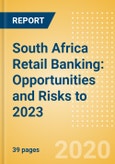Summary
The Total of outstanding loan balances (including outstanding credit card, personal loan and residential mortgage balances) in South Africa grew at a compound annual growth rate (CAGR) of 3.8% during 2014-18, to reach ZAR1.6tn ($111.2bn) in 2018. The majority of the population’s loan balances are from residential mortgages; home loans accounted for 57.4% of the total outstanding balances in 2018, followed by personal loan balances (35.1%) and credit card balances (7.5%). South Africans have very high household debt, as consumers borrowed large amounts to get through the prolonged economic slowdown.
All three loan segments grew at the same rate during the five-year review period. The total loan balance outstanding is expected to increase at a CAGR of 3.5% over the forecast period, to reach ZAR1.93tn ($134.2bn), as the economy continues to perform at a subdued rate, with macroeconomic fundamentals worsening further. The South African deposit market recorded a high CAGR of 10.5% over 2014-18, as consumers preferred to save rather than spend. Amid sustained economic slowdown and declining consumer confidence, the retail deposits market is expected to grow at a CAGR of 6.9% over 2019-23 to reach ZAR1,631.2bn ($113.4bn).
Based on our proprietary datasets, this report analyzes the South Africanlending market, with a focus on the consumer lending segment. The report discusses in detail the credit card, personal, and mortgage loan markets, covering market size, competitors’ market shares, and survey insights. The report also provides a market overview and insights on the retail deposit segment. In addition, it covers the key digital disruptors in theSouth Africanretail lending segment.
Scope
Reasons to Buy
The Total of outstanding loan balances (including outstanding credit card, personal loan and residential mortgage balances) in South Africa grew at a compound annual growth rate (CAGR) of 3.8% during 2014-18, to reach ZAR1.6tn ($111.2bn) in 2018. The majority of the population’s loan balances are from residential mortgages; home loans accounted for 57.4% of the total outstanding balances in 2018, followed by personal loan balances (35.1%) and credit card balances (7.5%). South Africans have very high household debt, as consumers borrowed large amounts to get through the prolonged economic slowdown.
All three loan segments grew at the same rate during the five-year review period. The total loan balance outstanding is expected to increase at a CAGR of 3.5% over the forecast period, to reach ZAR1.93tn ($134.2bn), as the economy continues to perform at a subdued rate, with macroeconomic fundamentals worsening further. The South African deposit market recorded a high CAGR of 10.5% over 2014-18, as consumers preferred to save rather than spend. Amid sustained economic slowdown and declining consumer confidence, the retail deposits market is expected to grow at a CAGR of 6.9% over 2019-23 to reach ZAR1,631.2bn ($113.4bn).
Based on our proprietary datasets, this report analyzes the South Africanlending market, with a focus on the consumer lending segment. The report discusses in detail the credit card, personal, and mortgage loan markets, covering market size, competitors’ market shares, and survey insights. The report also provides a market overview and insights on the retail deposit segment. In addition, it covers the key digital disruptors in theSouth Africanretail lending segment.
Scope
- The growth of mortgage loan balances in South Africa was down during 2014-2016, as macroeconomic fundamentals worsened amid prolonged recessionary economic conditions. The market rebounded in 2018, and also showed signs of improvement in 2019.
- South Africa’s relaxed lending criteria for unsecured loans in 2007 led to a phenomenal increase in consumer credit. With the inflation and unemployment rate continuously worsening, consumers took out more personal loans and defaulted on repayments.
- Retail deposits in South Africa experienced strong growth during the review period, as consumers preferred to save more than spend. Retail deposit balances in South Africa grew by 7.8% in 2018, which is the lowest growth rate since 2014, as gross disposable income decreased and the unemployment rate remained high.
Reasons to Buy
- Make strategic decisions using top-level historic and forecast data onthe South Africanretail lending industry.
- Identify the most promising lending segment.
- Receive detailed insights into lending in South Africa, including consumerlending.
- Understand the changing market and competitive dynamics by learning about new competitors and recent deals in the retail lending space.
- Receive comprehensive coverage of the retail deposit market in South Africa.
Table of Contents
Macroeconomic Overview- Consumer Lending: Mortgage Loans
- Consumer Lending: Personal Loans
- Consumer Lending: Credit Card Loans
- Retail Deposits
- Digital Disruptors
- Recent Deals
Appendix
Companies Mentioned (Partial List)
A selection of companies mentioned in this report includes, but is not limited to:
- Standard Bank
- ABSA
- First National Bank (includes WesBank)
- Nedbank
- Investec
- African Bank
- Capitec
- Discovery Bank
- TymeBank
- JUMO








